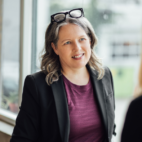How working side-by-side with client teams as collaborators, enablers, catalysts, and supporters is a powerful way to make positive change.
Sometimes we receive advice that initially sounds harsh but then reveals itself to be a gift that lives past the moment in which it was shared. This is the story of one short and pointed sentence that became a mantra that led me to The Moment.
Born and raised in Thunder Bay, Ontario, I left my home town to pursue university and a career in design. Eventually finding my way to Toronto, I loved being a designer and felt lucky to go to work everyday. I was an associate creative director in a downtown branding agency when I learned that my father was diagnosed with cancer. The five year experience of his illness and death changed how I viewed the world and shifted my priorities. It changed the kind of work I wanted to do and sent me headlong into an exploration to redefine meaning in my work. In essence, to find new purpose.
The learning curve
As a passionate learner I have always been drawn to the classroom and this led me to the Master of Design program in Strategic Foresight & Innovation at OCAD University. I didn’t know it at the time but my Letter of Intent was my first attempt at finding new meaning for my design skills. The application process became a reflection on the experience of my dad’s illness and provided an opportunity to question the disadvantages of geographic distance and how they might be overcome. Over the course of the next two years at OCAD, this reflection became the foundation for what would become my major research project, “Bridging the Distance: Communicating to Distance Family Members during Palliative Care.”
Halfway through the program, I met with someone in a leadership role at a local hospital. I was keen to understand if a design perspective might support innovation in health care and what opportunities might exist for someone with a design background. During our conversation he shared some very pointed advice:
“If you want to make change in health care, you need to be embedded. You won’t do it sitting in your studio.”
At the time it felt like a blow. I suspected that design, and particularly service design and participatory design, could contribute a valuable perspective — one that could engage with patients and families through a human-centered approach. But I had only ever experienced design from within a studio environment. As I completed the remaining courses, the advice stuck with me. In truth, I couldn’t stop thinking about it, “If you want to make change, you need to be embedded.”
When the time came to set-up an advisory team for my major research project, I kept this perspective top of my mind and knew that, in addition to a faculty advisor, my research would need to be grounded with a health care perspective to be truly relevant. Along with Dr. Kate Sellen at OCAD University, I was lucky to have Nancy Lefebre, Chief Clinical Executive and Senior Vice President of Knowledge and Practice, Saint Elizabeth Health Care, agree to be a secondary advisor. Her willingness to support an emerging design researcher explore the family experience of end-of-life was critical and provided a real-world view of the health care system. I had not left the design studio yet, but the door was beginning to open. Shortly after graduation, I was given the opportunity to join the Saint Elizabeth Research Centre as a design researcher. This was my chance to be embedded — to be part of the system from the inside. I jumped at the chance.
Making embedded change
I was a member of the Saint Elizabeth research centre for the next two and a half years. I was able to contribute a design-lens to projects of different scopes and scales, including two that were deeply connected to my personal experience: The Reflection Room, which applied an experiential design approach with shared storytelling to explore experiences with dying and death; and working with a rural Ontario hospice to co-design new services and programs to better support their community. Facilitating co-design and participatory sessions with patients, caregivers, family, doctors, clinicians, staff, and volunteers was deeply meaningful work. These engagements revealed that insights can emerge from not just active listening but also active participation in all phases of innovation — in understanding and reframing the problems we are trying to solve as well as imagining possibilities for solutions.
Co-design and participatory sessions revealed that insights can emerge from not just active listening but also active participation in all phases of innovation
Observing people with different experiences and perspectives, explore together, was always thought-provoking. Further, the people invited to participate in co-design activities not only welcomed the opportunity to share their lived experience, I often heard how much they valued engaging with others. I also learned a lot about what is required to do design work in health care.
In working on these research projects as a member of the team, I began to truly understand the benefits of being embedded as a key enabler of change. For example, I learned quickly that language can be a significant barrier. There is a very specific vocabulary to health care which often included many, many acronyms — almost a short-form approach to specificity. Similarly, design has its own language that is not always well understood outside the practice of design. It’s difficult to find a way forward without a common understanding. When you can authentically “speak the language” it goes a long way to obtaining support to do things differently.
Furthermore, the word “failure” — a much discussed concept in design and innovation work — is not relevant in health care. NOBODY wants to fail. In the health care context, people’s lives are at stake and failing can have dire consequences. If we want to talk about “iteration” as a learning technique, we would be better served by not attaching iteration to the word “fail”. Understanding the nuance of this context while working as an embedded designer with Saint Elizabeth Health Care helped reinforce the deep sense of responsibility I feel towards people — the human beings we design for and with when doing research and innovation work.
Embedding change through joined-up teams
Reading stories of design-driven innovation in health care from across the globe, and with three years of lived experience trying to lead it, I began to wonder if being embedded was the only way to make change. Was there a way to make positive change and actively draw in learnings from other sectors?
Having worked with The Moment as a service designer on a project for St. Joseph’s Health Care a couple years prior, I knew that when the time came to continue my exploration of purpose, they would be the first door I would knock on. The Moment stands out to me because of how they make choices about work aligned to purpose — to leave the world a better place. As an organization, they live the human-centered approach every day, embedding collaborative practice into project work and organizational structures. Only one question was left to be answered: What about working as an embedded practitioner?
I was excited to learn that Innovation Designers work side-by-side with client teams as collaborators, enablers, catalysts, and supporters.
One of the most appealing aspects of The Moment’s practice model is that of joined up teams. Rather than working in a traditional consultant model, I was excited to learn that Innovation Designers work side-by-side with client teams as collaborators, enablers, catalysts, and supporters. In many ways, this mirrored how I worked with my colleagues in the research centre — side-by-side with people of different backgrounds, skills, and subject matter expertise — sharing knowledge and contributing to a common goal. The spirit of being embedded felt aligned.
I’m so excited to have joined The Moment as an Innovation Designer. A decade long exploration of design, research, and purpose has led me here and I am keen to build on the very valuable lessons I’ve learned to support our work in health care. I’m equally eager to push my design practice, learning and working alongside my amazing new colleagues and to do my part to leave the world a better place.








